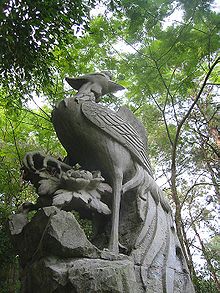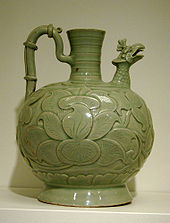- Fenghuang
-
For other uses, see Fenghuang (disambiguation).
Fenghuang 
Fenghuang sculpture, Nanning city, Guangxi, China Chinese name Traditional Chinese 鳳凰 Simplified Chinese 凤凰 Transcriptions Gan - Romanization fung5 uong4 Hakka - Romanization fung55 fong11 (Siyen dialect) Mandarin - Hanyu Pinyin Fèng Huáng Min - Hokkien POJ hōng-hông Wu - Romanization von waon, bon waon Cantonese (Yue) - Jyutping fung6 wong4 - Yale Romanization fung6 wong4 Japanese name Kanji 鳳凰 Hiragana ほうおう Transcriptions - Romaji hō-ō Korean name Hangul 봉황 Hanja 鳳凰 Transcriptions - Revised
Romanizationbong-hwang - McCune-
Reischauerponghwang Vietnamese name Quốc ngữ Phượng/Phụng Hoàng Fenghuang (Chinese: 鳳凰; pinyin: fènghuáng) are mythological birds of East Asia that reign over all other birds. The males are called Feng and the females Huang. In modern times, however, such a distinction of gender is often no longer made and the Feng and Huang are blurred into a single feminine entity so that the bird can be paired with the Chinese dragon, which has male connotations.
The Fenghuang is also called the "August Rooster" (Chinese: 鶤雞; pinyin: kūnjī) since it sometimes takes the place of the Rooster in the Chinese Zodiac. In the West, it is commonly referred to as the Chinese phoenix or simply Phoenix. Fenghuang Ancient City is an ancient community in Hunan Province.
However, the Fenghuang have no connection with the phoenix, which derives from Egyptian mythology. Peculiarly, the Egyptian phoenix may also in part reference a prehistoric bird, the Bennu Heron. Unlike the Fenghuang, which is a chimera not very much like any one extant bird, the Egyptian phoenix is most often considered similar to a heron or eagle.
Contents
Appearance
A common depiction was of it attacking snakes with its talons and its wings spread. According to scripture Erya - chapter 17 Shiniao, Fenghuang is said to be made up of the beak of a rooster, the face of a swallow, the forehead of a fowl, the neck of a snake, the breast of a goose, the back of a tortoise, the hindquarters of a stag and the tail of a fish.[1] Today, however, it is often described as a composite of many birds including the head of a golden pheasant, the body of a mandarin duck, the tail of a peacock, the legs of a crane, the mouth of a parrot, and the wings of a swallow.
Its body symbolizes the six celestial bodies. The head is the sky, the eyes are the sun, the back is the moon, the wings are the wind, the feet are the earth, and the tail is the planets. Its feathers contain the five fundamental colors: black, white, red, blue and yellow. It is also sometimes depicted as having three legs. It is believed that phoenix only appear in areas or places that are blessed with utmost peace and prosperity or happiness.
Chinese traditions cites it as living atop the Kunlun Mountains in northern China.[citation needed]
Origin
 A vase with a phoenix-headed spout, gray sandstone with celadon coating, Song Dynasty, last half of 10th century.
A vase with a phoenix-headed spout, gray sandstone with celadon coating, Song Dynasty, last half of 10th century.
Images of an ancient bird have appeared in China for over 4,000 years, the earliest as Shang Dynasty pottery motifs, then appearing decorating bronzes, as well as jade figurines (many of the most beautiful from the Liao Period)[citation needed]. Some believe they may have been a good-luck totem, believing that it is a totem of eastern tribes in ancient China. Current theories[citation needed] suggest that it is likely based in part - for example the snake-like neck - on folk memory of the Asian Ostrich which was common in prehistoric China but became extinct several thousand years ago. That this bird was well-known to the early modern humans in Asia, noted for its peculiarity, and hunted for food, is attested by numerous archaeological finds, such as pottery decorated with what appear to be painted ostriches, and bones by early campsites.[citation needed]
During the Han Dynasty (2,200 years ago) two phoenixes, one a male (feng, 鳳) and the other a female (huang, 凰) were often shown together facing one other. Later, during the Yuan Dynasty the two terms were merged to become the generally translated "phoenix", but the "King of Birds" came to symbolize the Empress when paired with a dragon as a dragon represented the Emperor. From the period of the Jiajing Emperor (1522–66) on, a pair of phoenixes was differentiated by the tail feathers of the two birds (typically together forming a closed circle pattern—the male identified by five serrated tail feathers (five being an odd, or yang number) and the female by what appears to be one, but is in fact, two (two being an even, or yin number) curling or tendrilled tail feathers. It was also in the Ming Dynasty that phoenixes first began to appear with combs, hence comb-less phoenixes are pre-Ming, and phoenixes depicted with combs, Ming or post-Ming.[2]
Also during this period, the feng huang was used as a symbol representing the direction south. This was portrayed through a male and female facing each other. Their feathers were of the five fundamental colors: black, white, red, green, and yellow. These colors are said to represent the Confucious' five virtues:
1. Ren is the virtue of benevolence, charity, and humanity; 2. Yi: Honesty and uprightness; Yì may be broken down into zhong, doing one's best, conscientiousness, loyalty and Shù: the virtue of reciprocity, altruism, consideration for others 3. Zhi: Knowledge 4. Xin: Faithfulness and integrity; 5. Li: Correct behavior, propriety, good manners, politeness, ceremony, worship. [3]
The phoenix represented power sent from the heavens to the Empress. If a phoenix was used to decorate a house it symbolized that loyalty and honesty were in the people that lived there. Or alternatively, phoenix only stays when the ruler is without darkness and corruption (政治清明).
Meaning
The Fenghuang has very positive connotations. It is a symbol of high virtue and grace. The Fenghuang also symbolizes the union of yin and yang. Shan Hai Jing - chapter 1 Nanshan jing records each part of Fenghuang's body symbolizes a word, the head represents virtue (德), the wing represents duty (義), the back represents propriety (禮), the abdomen says belief (信) and the chest represents mercy (仁).[4]
In ancient and modern Chinese culture, they can often be found in the decorations for weddings or royalty, along with dragons. This is because the Chinese considered the dragon and phoenix symbolic of blissful relations between husband and wife, another common yin and yang metaphor.
In some traditions it appears in good times but hides during times of trouble, while in other traditions it appeared only to mark the beginning of a new era.[5] In China and Japan it was a symbol of the imperial house, and it represented "fire, the sun, justice, obedience, and fidelity".[5]
Modern usage
- Phoenix talons (鳳爪) is a Chinese dish of chicken talons cooked in a black bean sauce. It can also mean "chicken talons" in the name of any Chinese dish cooked with it.
- Fèng or Fènghuáng is a common element in given names for Chinese girls (likewise, "dragon" is used for boys' names).
- "Dragon and Phoenix infants" (龍鳳胎) is an expression meaning a set of male and female fraternal twins.
- Fenghuang is also a county in western Hunan province of China, formerly a sub-prefecture. Its name is written with the same Chinese characters as the mythological bird.
- In Korea, the Chinese phoenix / fenghuang has been used for the royal emblem (more especially for Queens) and the presidential emblem.[citation needed]
- The Vermilion Bird of the South, one of the Four Symbols of Chinese myth, is sometimes confused with the Fenghuang, though they are distinct entities.[citation needed]
Sculpture by the S. Korean Presidential Residence.
See also
- Chinese dragon
- Chinese mythology
- Hōō-dō, Buddhist temple in Japan
- Ho-oh (Pokémon)
- Huma (Persian myths)
- Phoenix (manga)
- Phoenix (mythology)
- Phoenix Program, Vietnamese war operation
References
- ^ 《尔雅·释鸟》郭璞注,鳳凰特徵是:“雞頭、燕頷、蛇頸、龜背、魚尾、五彩色,高六尺许”。
- ^ Welch, Patricia Bjaaland. Chinese Art: A Guide to Motifs and Visual Imagery. Tuttle, 2008. Pp. 80 ff.
- ^ http://www.analects-ink.com/mission/Confucius_Five_Virtues.html
- ^ Shan Hai Jing - chapter 1. Nan Shang Jing - Nan Ci San Jing: 有鳥焉,其狀如雞,五采而文,名曰鳳凰,首文曰德,翼文曰義,背文曰禮,膺文曰仁,腹文曰信。是鳥也,飲食自然,自歌自舞,見則天下安寧。
- ^ a b Sources:
- "Hou-ou (or Hoo-oo)". http://www.onmarkproductions.com/html/ho-oo-phoenix.shtml. It's rumored to only land in areas where there is something precious underneath. Such as so, in one story, a man who saw a Fenghuang land on a patch of ground later returned to dig in that area and salt was discovered.
External links
Chinese mythology Overview topics Major entities Creatures Bixie · Black Tortoise · Azure Dragon · White Tiger · Vermilion Bird · Qilin · Fenghuang · Huli jing · Chinese guardian lions · Píxiū · NiánPlaces Popular literary works Shan Hai Jing · Shi Yi Ji · The Peach Blossom Spring · Fengshen Bang · Legend of the White Snake · Strange Stories from a Chinese Studio · Journey to the West · In Search of the Supernatural · Zi Bu Yu · Tian Xian PeiCategories:- Asian legendary creatures
- Chinese mythology
- Legendary birds
- Chinese legendary creatures
Wikimedia Foundation. 2010.



